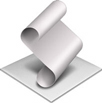Interface
By: Mike Yocom - Revised: 2006-06-06 devinIntroduction
Discusses Mac OS X's interface including "Aqua" and AppleScript.Section Links

There are two basic window schemes in Mac OS X: pinstripe and brushed metal.
Mac OS X uses drop shadows to better define the borders of windows. The foreground window has a larger shadow, giving a quick, visual clue as to which window is in front.
Entire windows, not just outlines, track with the pointer when a user moves things around. Likewise, window contents update in real time as a user scrolls, instead of waiting to jump to the new location when the mouse button is released.
Window controls in the foreground window are conveniently color-coded: red to close a window, yellow to minimize a window into the dock, and green to zoom the window. (The color coding can be turned off.) When a user mouses over a window control button, useful symbols — "x" for close, "−" for minimize, "+" for zoom — appear in the buttons. When there are unsaved changes in a document, the close button has a dot in it at all times to clue the user.
Instead of creating yet another window when saving a new document, a pane appears, attached to the window of the document in question. This means that there is no confusion as to which new document is being saved. Save dialogs also don't halt the program — except in Carbonized applications — allowing users to work on other documents if they remember something important that needs to be added quickly, instead of having to close the save dialog, make the additions, and then repeat the process of saving a new dialog.
Aqua expands on the classic Mac OS' Icon and List Views with Column View. This allows users to switch into a different folder at any higher level. Column View also has a preview column, which allows users to get an idea of what a particular document really is, without having to launch a program first.
Jaguar also adds a feature from classic Mac OS that many users missed: spring-loaded folders. When dragging an object from one location to another, users can just hold the object over a folder for a moment, and the folder will automatically open up, so users don't have to browse through to the new location first.

AppleScript, the scripting language based on the natural language metaphor that has long been available for the classic Mac OS, is natively available in Mac OS X. In fact, AppleScript Studio is free with Mac OS X, and works in conjunction with the Cocoa-based ProjectBuilder framework for GUI elements.
AppleScripts can be used to control programs, allowing users to automate workflow. AppleScripts can also be created as stand-alone applets to automate common tasks — converting from one unit of measurement to another, for example.
Because AppleScript is designed around normal, English syntax, it is much easier for people — especially people with no programming experience — to learn to use than normal programming languages.
- Documentation
- Administration
- Authentication
- General Software
- Hardware
- Miscellaneous
- Multimedia
- Networking
- Operating Systems
- Outside Presentations
- Programming & Scripting
- Security
- Servers
- Short Courses
- System Deployment
- System Utilities
- What's New

